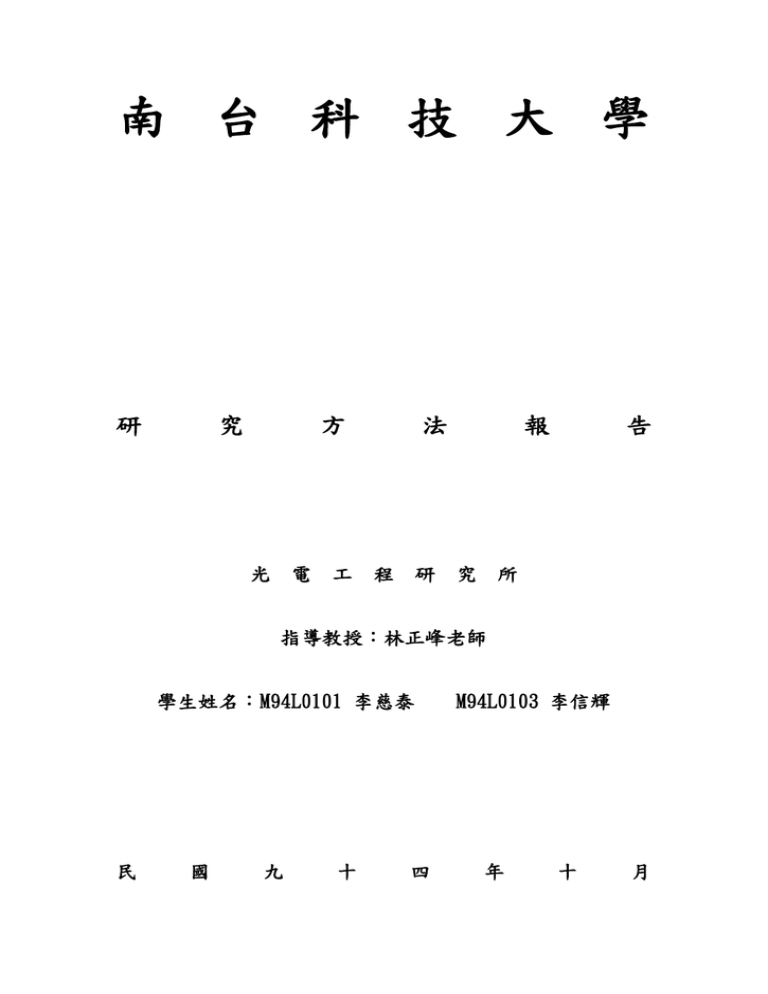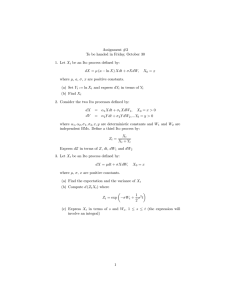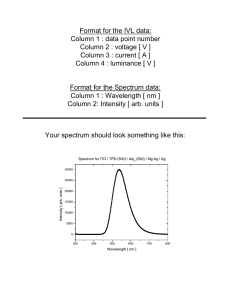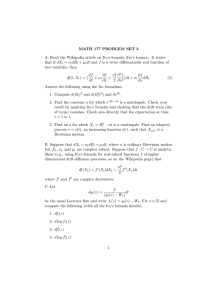
南 台 科 技 大 學
研
究
方
光
電
工
法
程
研
報
究
告
所
指導教授:林正峰老師
學生姓名:M94L0101 李慈泰
民
國
九
十
四
M94L0103 李信輝
年
十
月
1. http://datas.ncl.edu.tw/theabs/1/
2. Key in “OLED”
4. Press “搜尋”
3. Search condition
2. 排序的方式
1. Search result
2. 每頁的筆數
預覽及儲存檢索結果
1. Key in “OLED”
2. Key in “Ni”
3. Press “搜尋”
Search result
1. Key in “OLED”
2. Key in “Ni”
3. Key in “ITO”
Search result
4. Press “搜尋”
Press “預覽”
第 1 筆
B 國家圖書館索書號 b:
系統編號: 92NCKU5063008
出版年: 民 2004/02/05
研究生: 詹逸民
I-Min Chan
(以研究生姓名查詢國家圖書館索書號 ,未查獲者表國圖尚未典藏)
(以研究生姓名查詢國科會科資中心微片資料庫)
(連結至全國圖書聯合目錄)
(連結至政大圖書館館藏目錄)
電子全文: 電子全文下載
論文名稱: 高效能有機發光元件製作技術之研究
論文名稱: The Study of High Performance Organic Light Emitting
Devices
指導教授: 洪昭南
Franklin Chau-Nan Hong
學位類別: 博士
校院名稱: 國立成功大學
系所名稱: 化學工程學系碩博士班
學年度: 92
語文別: 中文
論文頁數: 187
關鍵字: 顯示器
photochemistry
光化學
organic light-emitting diode
有機發光二極體
display
[摘要]
本論文主要分為三大部分,第一部份針對有機發光二極體(OLED)元件用的氧化銦錫(indium tin oxide-ITO)陽極做了改
善處理,藉由開發的大氣壓電漿處理方式、氧化鎳(NiO)無機改質膜和開發了四氟化碳/氧(CF4/O2)混合型氣體電漿,效
果更勝於傳統的氧氣(O2)電漿。 第二部分則是針對傳統雙層元件的缺點做改善,加入適當的電洞阻擋層可以大幅的增進
元件效能,並利用多重激發子(exciton)或載子(carrier)侷限結構進一步改良三層元件的效能。 第三部分是利用 TPD 分子
與 BPhen 或 BCP 分子複合所產生的特殊光電現象,異核複合分子(exciplex)與電致異核複合分子(electroplex),將元件設
計為模糊接面(fuzzy-junction),我們可以發出不同於 TPD 與 BPhen 或 BCP 波長的光並達到相當高的亮度與
效率。
ITO 為目前在平面顯示器上最廣為使用的透明導電電極,其具有相當好的導電性和在可見光區的高穿透率,但由於
ITO 的功函數(work function)相較於其它金屬氧化物仍屬偏低導致高能障(energy barrier)存在於 ITO 電極和有機層中,此
一能障會阻礙電洞(hole)注入於元件之中。我們發展介電阻抗式(dielectric barrier discharge-DBD)大氣電漿處理 ITO 電極表
面可以改善雙層元件的電流-電壓-輝度(I-V-L)特性,降低電流起始電壓,N,N'-Bis(3-methylphenyl)-N,N'bis(phenyl)benzidine(TPD)/Tris-(8-Hydroxyquinolinol) Aluminum (Alq3) 雙層元件最大亮度從無電漿處理的 6645 cd/m2 (12
V)提高到 14238 cd/m2 (10.2 V),1cd/m2 的亮度起始電壓從 6.7 V 降到 4.5 V,流明效率(lm/W)比傳統的 O2 電漿提升 40 %,
以 XPS 光譜分析其 Sn+4 的濃度,我們提出了其可能的功函數增加機制。
我們另外提出使用 CF4/O2 混合型電漿源來處理 ITO 電極表面將會比單純使用 O2 電漿得到更好的元件特性。 元
件亮度到達 1 cd/m2 時為元件亮度起始電壓可以降到 3.25 V,比 O2 的 4.6 V 更低,x-ray 光電子分析儀(XPS)分析 F 1s 的
鍵結能在 685 eV 表示 F 鍵結在 ITO 表面的銦(In)或是錫(Sn)上,導致一負電荷在外的偶極(dipole),進而增加表面的功函
數。
另一個改善方法是在 ITO 表面利用反應濺鍍製程鍍上一層約數奈米(nm)的高功函數薄膜,氧化鎳(NiO),如此一
來可以讓此一複合式陽極同時具備高功函數和高穿透率。藉由此一方法元件的 1 cd/m2 亮度起始電壓可以進一步降至 3 V
以下,藉由單一電洞載子元件(hole-onlydevice)和選擇性在 ITO 上濺鍍 NiO 條狀圖案的元件製作,驗證了 NiO 的確對電
洞的注入有大幅的幫助。
元件使用雙層結構一般來說電洞會過多,如何有效的將電洞侷限在發光層中是一個高效能元件結構設計的首要重點。
我們利用 4,7-diphenyl-1, 10-phenanthroline (BPhen)相當低的最高已鍵結軌域能階(HOMO energy level-6.2 eV)可以有效
的將電洞阻擋在發光層 Alq3 中,且其同時具備電子傳輸能力和不會對電子從陰極注入形成能障的優點,使用
TPD/Alq3/BPhen 三層簡單結構我們可以將元件起始電壓降到 3 V 左右並達到~60000 cd/m2 (11 V)的高亮度和 5 cd/A 的高
效率。針對此一結構我們使用介電質火炬式(barrier-torch discharge plasma-BDP)大氣電漿系統進行 ITO 電極表面處理,最
後我們可以得到 2.5~3 V 的低起始電壓和 86100 cd/m2 (9.5 V)的超高亮度和平均>6 cd/A 的高效率,這些結果都是目
前非摻雜系統並單純使用 Alq3 當發光材料中的最高紀錄。
BPhen 雖然是一個相當好的電洞阻擋材料但是因為其具相當程度的平面結構,因此會有分子自我聚集現象產生
(self-aggregation),材料 Tg 點相當低,影響元件效能。 利用甲基(methyl-group)對 BPhen 進行修飾可以得到另一個相當
常用的電洞阻擋材料 2,9-dimethyl-4,7 diphenyl-1,10- phenanthroline (BCP)。使用由 TPD/Alq3/BCP 三層所構成的元件,
其效能不如使用 BPhen 來得突出,所以針對此一材料我們設計了多重量子井結構來侷限激發子和載子,最後可以得到
2.5 V 的低起始電壓,62800 cd/m2 的高亮度平均超過 6 cd/A 的高效率,載子侷限效應被提出來解釋此一現象。
具良好平面結構和相似的 HOMO 或 LUMO 能階的電洞傳輸材料和電子傳輸材料會形成異核複合分子(exciplex),
一般被認為對元件有不良的影響,我們發現使用 TPD 和 BPhen 即會形成此一現象,我們利用模糊界面(fuzzy-junction)的
結構設計大幅增加異核複合分子的產生,發展出利用此一現象發光的 OLED 元件,成功得到~480 nm 波長的藍綠光,並
非 TPD 或是 BPhen 約 400 nm 的紫外光,令人感到興趣的是此一元件的效能相當不錯,低亮度起始電壓約 2.5~3 V,5440
cd/m2 (8.5 V)的高亮度和高效率(1.8 cd/A 或 1.4 lm/W 在 4 V),藉由光致激發光譜(PL)和吸收光譜(UV-Visible)的驗證的
確是由異核複合分子發光,我們在 EL 的實驗另外發現了相當強且少見的電致異核複合分子(electroplex)現象,波長在~515
nm 的綠光範圍,因為此一現象和外加電場有關,因此元件的發光波長會隨電壓的增加而從原先的藍綠光飄移到綠光,
若是使用 TPD 和 BCP 系統則因為 TPD*在此一系統較容易生成,尤其是高操作電壓,導致元件的發光波長會隨電壓的
增加而從原先的藍光飄移到 TPD*的藍紫光,顏色飄移現象相當明顯以致於可以直接由肉眼看見,相關機制亦被提出解
釋此一特殊元件的電致發光行為。
第 2 筆
B 國家圖書館索書號 b:
系統編號: 92STUT0442015
出版年: 民 93
研究生: 呂竟楓
Ching-Feng Lu
(以研究生姓名查詢國家圖書館索書號 ,未查獲者表國圖尚未典藏)
(以研究生姓名查詢國科會科資中心微片資料庫)
(連結至全國圖書聯合目錄)
(連結至政大圖書館館藏目錄)
論文名稱: 表面 Ni 摻雜 ITO 陽極在可撓式 OLED 之應用研究
論文名稱: Investigation of Surface Ni-doped ITO Anode for Flexible
Organic Light-Emitting Diode Applications
指導教授: 許進明
Ching-Ming Hsu
學位類別: 碩士
校院名稱: 南台科技大學
系所名稱: 電機工程系
學號: M9120106
學年度: 92
語文別: 英文
論文頁數: 84
關鍵字: 氧化銦錫
有機電致發光顯示元件
indium tin oxide (ITO)
flexible organic lightemitting diode (FOLED)
[摘要]
本研究分別以交流(RF)濺鍍法與直流(DC)濺鍍法在低溫下共成長鎳(Ni)摻雜的氧化銦錫(Indium Tin Oxide, ITO)薄膜於
ARTON 塑膠基板上。最佳的 ITO 成膜條件分別是濺鍍壓力為 2.35 mtorr、功率為 80 W 及基板溫度為 45
C,利用此
最佳成膜條件,研究 ITO 膜表面 Ni 摻雜對於 ITO 膜的片電阻值(Ω/sq)、光穿透率(T%)、表面粗糙度及功函數等特性之
影響,並藉由 155
C 12 hr 的真空退火來改善 ITO 膜的光電特性。然後再製作有機電致發光顯示元件(OLED)來觀察元
件特性受 Ni 摻雜濃度的影響程度。實驗結果顯示,未摻雜 Ni 的 ITO 膜片電阻值為 72 Ω/sq、穿透率為 89.33 %、粗糙
度為 1.53 nm 和功函數為 4.73 eV。在此條件下製作的 Al(50 nm)/Alq3(35 nm)/NPB(20 nm)/ITO(150 nm)/Arton OLED 元件,
起始電壓為 8.7 伏特。經過 Ni 摻雜而濺鍍功率為 90 W 的 ITO 膜,其片電阻值可降到 59.2 Ω/ sq、穿透率則為 86.15 %、
粗糙度改善至 1.3 nm,且功函數提高到 5.09 eV。使用此參數製作 OLED 元件,則起始電壓降低至 7 伏特,比未摻雜時
的 8.7 伏特改善了 1.7 伏特。其亮度在 15 伏特時可達 10100 cd/m2。在一般 OLED 元件的操作亮度下(100 cd/m2) ,光電
轉換效率可達到 2.06 lm/W,比未摻雜時的光電效率 1.53 lm/W 為佳。但亮度為 5000 cd/m2 時,光電轉換效率則由未摻
雜的 1.39 lm/W 降為 1.34 lm/W,顯示在高電流時電子-電洞的復合效率反而降低。
實驗結果證明即使是製作在塑膠基板的低溫 ITO 製程,仍然可以利用鎳摻雜來獲得高品質的 ITO 膜,並提高 OLED 元
件的光電效率。
第 3 筆
B 國家圖書館索書號 b:
系統編號: 91STUT0442003
出版年: 民 92
研究生: 李晉文
(以研究生姓名查詢國家圖書館索書號 ,未查獲者表國圖尚未典藏)
(以研究生姓名查詢國科會科資中心微片資料庫)
(連結至全國圖書聯合目錄)
(連結至政大圖書館館藏目錄)
論文名稱: 鎳摻雜-氧化銦錫透明導電膜最佳化於有機電致發光元件之應用
指導教授: 許進明
學位類別: 碩士
校院名稱: 南台科技大學
系所名稱: 電機工程系
學號: m9020105
學年度: 91
語文別: 中文
關鍵字: 有機電致發光元件
OLED
顯示器
[摘要]
本論文第一部分先以直流式(DC)磁控濺鍍法,製作氧化銦錫(Indium Tin Oxide)薄膜,製程中改變不同的濺鍍參數,如壓
力、功率、基板溫度等等,以觀察這些參數對 ITO 電阻率(ρ),光穿透率(T%),表面粗糙度等特性之影響,並使用 300
C 之高真空退火處理達到最佳條件,以製作有機電致發光顯示元件(OLED)。第二部分再以交流式(RF)磁控濺鍍法,以
共鍍的方式摻雜鎳(Nickel)金屬薄膜到 ITO 薄膜的表面,其中嘗試更改不同的濺鍍參數,如功率、鍍膜時間、分子流量
等等,以觀察這些參數對此摻雜薄膜之電阻率(ρ),光穿透率(T%),表面粗糙度、摻雜濃度等特性之影響,並使用 300
C 之高真空退火處理達到最佳條件,以製作有機電致發光顯示元件(OLED)。
第一部分實驗結果發現,在 Ar=5.6sccm,Temperature=120
C,Power=300W 時會有最佳沈膜條件,電阻率為 2.4E-4
Ω-cm,穿透率為 91.7%。使用此最佳化製作 OLED 其結構如下:Al(50nm)/Alq3(35nm)/NPB(20nm)/ITO(200nm)/glass,
顯示 turn-on 電壓 12V。而第二部分實驗結果發現,在 Power=50W,濺鍍摻雜時間=90sec 時會有最佳摻雜沈膜條件,電
阻率降到 2.0E-4Ω-cm,穿透率則為 90%。使用此最佳化製作 OLED 其結構如下:Al(50nm)/Alq3(35nm)/NPB(20nm)/ITO
Dopant Ni(200+ 4.5nm)/glass,顯示 turn-on 電壓 6.5V。本實驗顯示 ITO 摻雜 Ni 金屬薄膜若作為 OLED 顯示器之應用,
可降低其整體 turn-on 電壓,並在 15V 有最大亮度 2611cd/m2,光電轉換效率達 1.093lm/W 有效降低 OLED 的功率消耗
達 0.914lm/W。
第 4 筆
B 國家圖書館索書號 b:
系統編號: 88NCTU0500071
出版年: 民 89
研究生: 黎安國
An-Kuo Li
(以研究生姓名查詢國家圖書館索書號 ,未查獲者表國圖尚未典藏)
(以研究生姓名查詢國科會科資中心微片資料庫)
(連結至全國圖書聯合目錄)
(連結至政大圖書館館藏目錄)
論文名稱: 以化學氣相沉積聚合芳香烴乙烯聚合物薄膜及其在發光二極體之應
用
論文名稱: Synthesis of Poly(arylene vinylenes) by Vapor Deposition
Polymerization and Their Application in Light-Emitting
Diode
指導教授: 許千樹
Chain-Shu Hsu
學位類別: 博士
校院名稱: 國立交通大學
系所名稱: 應用化學系
學號: 8425514
學年度: 88
語文別: 中文
論文頁數: 171
關鍵字: 芳香烴乙烯聚合物
poly(arylene vinylenes)
化學氣相沉積聚合
photoluminescence
有機發光二極體
electroluminescence
電激發光
organic light emitting
diodes
光激發光
vapor deposition
polymerization
[摘要]
本論文研究目的乃是探討以氣相沉積聚合反應(VDP)取代傳統有機電激發光元件製程中薄膜成長的技術,以期
得到一個方便、快速以及乾淨的薄膜成長方式。本研究主要分為四個部份:
前三部份主要針對不同單體系統進行氣相沉積聚合反應(VDP)合成電激發光用聚芳香烴乙烯(Poly(arylene
vinylene), PArV)聚合物薄膜,以探討此方法用於各種單體系統之可行性。第一部份係針對在 2, 5 位置導入甲基(CH3)
及甲氧基(OCH3)等小推電子基為基本架構的單體行氣相沉積聚合反應,得 poly(2,5-dimethyl-1,4-phenylene vinylene)
(DMe-PPV)及 poly(2,5-dimethoxy-1,4-phenylene vinylene)(DOMe-PPV)衍生聚合物;第二部份主要利用氣相沉積
聚合反應聚合以苯環等大取代基為基本架構的 PPV 衍生聚合物,研究中在單體 2,3 位置導入苯環或琉苯(S-Ph)等較
大取代基為主,得 poly(2-phenyl-1,4-phenylene vinylene)(P-PPV)
、poly(2,3-diphenyl-1,4-phenylene vinylene)(DP-PPV)
及 poly(2- phenyl sulfhydryl-1,4-phenylene vinylene)(PS-PPV)等衍生聚合物;第三部份主要利用氣相沉積聚合方法合
成以 naphthalene 及 anthracene 為主鏈結構的 PArV 衍生聚合物,得 poly(1,4-naphthalene vinylene)(1,4-PNV)
、poly(2,
6-naphthalene vinylene)(2,6-PNV)
、poly(2,3-diphenyl-1,4-naphthalene vinylene)(DP-PNV)及 poly(9,10-anthracene
vinylene)(PAV)
。三系列聚合物單體分別在高真空下經昇華氣化後,在 650-800℃下經高溫瞬間真空裂解(Flash Vacuum
Pyrolysis)成活化中間體(reactive intermediate)
,再由不同基材溫度條件下進行氣相沉積聚合反應聚合成前驅物高分子,
經回火(annealing)處理後得到我們所要的共軛高分子薄膜。本研究將探討各類單體因不同的昇華速度、熱解溫度、基
板溫度及熱脫去的條件,所造成聚合程度上的差異,並利用 FT-IR、UV-Vis 及其他光學儀器鑑定其化學結構及光電性質,
更進一步利用循環電位伏安法(CV)確定所得聚合物能隙大小,並將其用於單層 OEL 元件製作上。研究中發現各單體
裂解溫度均高於 650℃以上,除了 DMe-PPV 聚合溫度為 90℃外,各單體聚合溫度均控於 0℃附近,且研究發現,在各
項反應條件控制得宜下,聚合物單體惟有形成酉昆式(quinoid)結構的活化中間體,才有行聚合反應之可能性,亦即一
般認為這類單體在行傳統前驅物法(如:chlorune precursor route, CPR)或氣相沉積聚合反應中是以 biradical 形式反應,
而非離子聚合(ionic polymerization)
,因此反應真正單體應是酉昆式結構,在我們的氣相沉積聚合反應中則以 halogenated
quinodimethane 為我們所預期之活性單體,因此在裂解過程中單體應唯有進行 1,6-dehydrohalogenation 反應,才可得到
共軛良好之高
分子薄膜,研究顯示在三系列的單體中大部分單體皆有行 1,6-dehydrohalogenation 之可行性,只有 2,6-PNV 單體因要
形成酉昆式所需的共軛結構太長,造成其聚合失敗。三系列共軛高分子中,部份薄膜之光學及電氣性質與傳統聚合方法
所得之高分子薄膜有所不同,由各系列聚合物之 CV 及 UV-Vis 圖譜可發現此方法所得之薄膜 HOMO 及 LUMO 皆較傳統
值為大,更有利於與正、負電極能階之匹配,除了 PNV 系統外,其能隙(bandgap)與傳統方法所得之薄膜差異不大,
顯示此聚合方法所得高分子的共軛長度與傳統方法相當,由 CV 圖譜更可看出三系列高分子氧化還原反應皆屬不可逆狀
態;三系列共軛高分子在製作成單層 OEL 元件時,驅動電壓皆可低於 10 Volt,且以聚合物 DMe-PPV 在沒有封裝條件下,
其生命期(lifetime)可達 6 小時以上,且在 12 V 電壓驅動下具有 100 cd/m2 以上之亮度,為最成功之元件製作。
本研究最後選擇上面三系列聚合物中電氣性質穩定且能隙(bandgap)能互相匹配之高分子製作雙層 OEL 元件。
傳統高分子塗佈法在製作多層 OEL 元件時所面臨的第一個問題即溶劑的選擇,不同的高分子層要使用不同的溶劑,且
彼此間要不會互溶,以避免高分子界面間的溶漲(swelling)現象產生。我們藉由氣相沉積聚合方法可避免溶劑的使用,
且直接就可得到一高分子薄膜,因此我們利用此方法製作雙層 OEL 元件避免了溶劑的使用,解決了製作多層高分子元
件的瓶頸。此部份我們初步選擇 DMe-PPV 作為元件的第一層,PNV 作為元件的第二層,結果發現 DMe-PPV 在此元件
中已由發光層轉變為修飾(modify)ITO 表面的功用,以及電洞傳輸層的雙重作用,使原先發光效率較低且生命期(lifetime)
較短的 PNV 有比原先較好的電氣性質,因此,利用氣相沉積聚合方法我們成功地得到了一個雙層的 OEL 元件,相信在
未來利用此方法應可得到多層(multilayer)的元件,以達全彩之目標。
1. http://sticnet.stpi.org.tw
2. Press “國內資料庫”
2. Press “學術會議論文摘要”
2. Press “進階查詢”
1. Key in “OLED”
2. Key in “Ni”
3. Key in “ITO”
4. Press “搜尋”
第 1/2 筆科資中心編號: CD9301-0281
題名: Dependence of Ni - ITO Co-Sputter ITO Film Property on Ni Concentration
作者: Lu, Ching-Feng ; Hsu, Ching-Ming
機構名稱: 南台技術學院電機工程系
Dept. of Electrical Engineering, Nantai Inst. of Technology, R.O.C.
會議名稱: 國際奈米科技研討會
2003 International Symposium on Nano Science and Technology
會議地點: 南台科技大學
Southern Taiwan University of Technology
會議日期: 2003/11/04 - 2003/11/07
主協辦單位名稱: 南台科技大學
Southern Taiwan University of Technology; National Cheng Kung University; Tainan County Government
出版品名稱: 國際奈米科技研討會論文集; Proceedings of 2003 International Symposiun on Nano Science and Technology
起迄頁: 191-192
語文: 英文
原件提供: IJ0000-6546
科資分類號: CB0608
關鍵詞: 氧化銦錫 ; 鎳 ; 共濺鍍 ; 薄膜
Indium Tin Oxide ; Nickel ; Co-Sputtering ; Film
英文摘要: A Ni - ITO co-sputter method was employed to fabricate ITO films with a top Ni -doping surface layer. The goal of
this study is to enhance opto-electrical performance of OLED devices. The influences of the Ni concentration on the properties of
Ni - ITO co-sputtered ITO film such as optical transmittance and sheet resistivity were investigated. Results show that the optical
transmittance of the ITO film decreases with increasing Ni concentration from 91.7% to 90% after thermal annealing and the
sheet resistivity as low as 2.0E-4..OMEGA.-cm can be achieved.
原件內容型式: 全文
原文申請:
第 2/2 筆科資中心編號: CD9301-0281
題名: Dependence of Ni - ITO Co-Sputter ITO Film Property on Ni Concentration
作者: Lu, Ching-Feng ; Hsu, Ching-Ming
機構名稱: 南台技術學院電機工程系
Dept. of Electrical Engineering, Nantai Inst. of Technology, R.O.C.
會議名稱: 國際奈米科技研討會
2003 International Symposium on Nano Science and Technology
會議地點: 南台科技大學
Southern Taiwan University of Technology
會議日期: 2003/11/04 - 2003/11/07
主協辦單位名稱: 南台科技大學
Southern Taiwan University of Technology; National Cheng Kung University; Tainan County Government
出版品名稱: 國際奈米科技研討會論文集; Proceedings of 2003 International Symposiun on Nano Science and Technology
起迄頁: 191-192
語文: 英文
原件提供: IJ0000-6546
科資分類號: CB0608
關鍵詞: 氧化銦錫 ; 鎳 ; 共濺鍍 ; 薄膜
Indium Tin Oxide ; Nickel ; Co-Sputtering ; Film
英文摘要: A Ni - ITO co-sputter method was employed to fabricate ITO films with a top Ni -doping surface layer. The goal of
this study is to enhance opto-electrical performance of OLED devices. The influences of the Ni concentration on the properties of
Ni - ITO co-sputtered ITO film such as optical transmittance and sheet resistivity were investigated. Results show that the optical
transmittance of the ITO film decreases with increasing Ni concentration from 91.7% to 90% after thermal annealing and the
sheet resistivity as low as 2.0E-4..OMEGA.-cm can be achieved.
原件內容型式: 全文
原文申請:
4. 可選擇存檔方式
1. Key in “www.ei.org”
2. Press here
1. Key in “OLED”
2. Key in “Ni”
3. Key in “ITO”
5. Press “Search”
Search condition
Press “Select all on page”
1. Choice “Abstract”
2. Press “View Selections”
1.
Surface Ni-doped ITO Films for OLED application
Hsu, Ching-Ming (S. Taiwan University of Technology, Department of Electrical Engineering); Chen, Ian-Fu; Lee, Jin-Win
Source: Proceedings of SPIE - The International Society for Optical Engineering, v 5214, Organic Light-Emitting Materials
and Devices VII, 2004, p 291-299
ISSN: 0277-786X CODEN: PSISDG
Conference: Organic Light-Emitting Materials and Devices VII, Aug 4-6 2003, San Diego, CA, United States Sponsor:
SPIE
Publisher: International Society for Optical Engineering
Abstract: Transparent conductive indium tin oxide (ITO) films with thin Ni-doped surface layers were prepared for organic light
emitting diode (OLED) application. The top Ni-doped ITO surface layer were synthesized using Ni (RF) and ITO (DC)
co-sputtering method at 120°C and annealed at 300°C for 10 minutes in vacuum to form a modulated work function layer in
contact with the subsequently deposited light emitting organic layers. OLED devices with an Al/Alq3/NPB/Ni-doped
ITO/ITO/glass structure were fabricated to investigate the effect of the Ni-doped ITO layer on the characteristics of the
luminescence efficiency. The depositions of the Al/Alq3/NPB stacked films on top of the Ni-doped ITO/ITO/glass sample were
conducted using thermal evaporation in a cluster tool without breaking the vacuum. Initial results show that the device turn-on
voltage decreases from 10 volts to 6 volts and the luminescence efficiency was improved by 36% due to the existence of the
Ni-doped ITO layer. It was also found that the optical transmittance of the ITO film decreased with the Ni concentration,
resulting in external quantum efficiency deterioration by 3%. It was suspected that the presence of Ni (Φ [similar to] 5.2eV
compared to that of ITO [similar to] 4.2eV) on ITO surface decreases the heterojunction barrier height at the ITO/NPB interface,
allowing more effective transportation of hole-carriers and hence an enhancement on the external quantum efficiency. However
the optical impurity scattering of the Ni atoms in the ITO matrix caused the deterioration of the optical transparency and negative
effect on the external quantum efficiency. (13 refs.)
Ei controlled terms: Conductive films | Nickel | Light emitting diodes | Synthesis (chemical) | Sputtering | Vacuum | Lighting |
Deterioration | Quantum theory | Electric potential | Interfaces (materials) | Functions
Database: Compendex
Full-text and Local Holdings Links
SDOS | NCKU Library Holding
2. Preparation and characterization of Ni-indium tin oxide cosputtered thin films for organic light-emitting diode application
Hsu, Ching-Ming (Department of Electrical Engineering, S. Taiwan University of Technology); Lee, Jin-Win; Meen,
Teen-Hang; Wu, Wen-Tuan Source: Thin Solid Films, v 474, n 1-2, Mar 1, 2005, p 19-24
ISSN: 0040-6090 CODEN: THSFAP
Publisher: Elsevier
Abstract: The characteristics of organic light-emitting diode (OLED) can be improved by the doping of nickel (Ni) into indium
tin oxide (ITO) anode. Ni-doped ITO films were synthesized using Ni and ITO cosputter approach. Film properties, such as
surface roughness, optical transmittance, sheet resistivity, and surface work function, independent of Ni-doping level were
examined. Results show that the Ni-doped ITO films perform lower surface roughness and higher surface work function-without
scarifying the optical transmittance after thermal annealing at 300°C. OLED devices with an
Al/tris(8-hydroxyquinoline)aluminum/N,N'-bis- (1-naphthyl)-N,N'-diphenyl-1,1'biphenyl-4,4'-diamine/ITO/glass structure
were fabricated to investigate the effect of the Ni-doped ITO anode. From the I-V characteristics of the OLED devices, the
threshold voltage can be reduced from 12 to 8 V when the Ni atomic concentration is greater than 1.8%. © 2004 Elsevier B.V. All
rights reserved. (18 refs.)
3. Characterization of new red dopants for red color OLED
Sung, Hyun Ho (NIES, Korea Electron. Technol. Institute); Kim, In Hoe; Byun, Ki Nam; Yoo, Han Sung Source: Current
Applied Physics, v 5, n 4, May, 2005, p 345-347
ISSN: 1567-1739
Publisher: Elsevier
Abstract: New type red dopants N,N prime -bis[4-( N,N -dimethylamino)- benzylidine]diaminomaleonitrile (M), N,N prime
-bis [8-hydroxy-1,1,7,7-tetramethyljulolidine]diaminomaleonitrile (R-11a) have been synthesized and used as a red dopant for
red color OLED with narrow full-width at half-maximum (FWHM). The M and R-11a were synthesized by the reaction between
diaminomaleonitrile and benzaldehyde in acetic acid. They showed more narrow full-width at half-maximum(FWHM) than
asymmetric DCM series because they had a symmetric structure. Their photoluminescence and electroluminescence properties
were examined and compared. The PL and EL peaks of films consisted of Alq3 and dopants were 620 nm (M), 624 nm (M) and
660 nm (R-11a), 660 nm (R-11a), respectively. Red organic light emitting devices(OLEDs) with these rede dopants have been
fabricated. OLEDs have a configuration of ITO/TPD/Alq3:dopant/Alq3/LiF/Al. The electrical and optical properties of the
devices were investigated. © 2004 Elsevier B.V.All rights reserved. (5 refs.)
4. High-Performance Organic Light-Emitting Diodes Using ITO Anodes Grown on Plastic by Room-Temperature
Ion-Assisted Deposition
Yang, Yu (Department of Chemistry, Materials Research Center, Northwestern University); Huang, Qinglan; Metz,
Andrew W.; Ni, Jun; Jin, Shu; Marks, Tobin J.; Madsen, Mark E.; DiVenere, Antonio; Ho, Seng-Tiong Source: Advanced
Materials, v 16, n 4, Feb 17, 2004, p 321-324
ISSN: 0935-9648 CODEN: ADVMEW
Publisher: Wiley-VCH Verlag
Abstract: The growth of high-quality indium tin oxide (ITO) thin films on both glass and plastic by ion-assisted deposition (IAD)
was discussed. The organic light-emitting diode (OLED) response characteristic with these films as transparent electrodes was
also presented. It was found that the AD-derived ITO was of high quality with smooth surfaces, high conductivity and high
transparency. The results also showed that the IAD-derived ITO affords OLED performance that rivals or exceeds that of devices
fabricated with commercial ITO/glass anodes. (25 refs.) (Edited abstract)
5. On the problem of microcavity effects on the top emitting OLED with semitransparent metal cathode
Lee, C.J. (Information Display Research Center, Korea Electron. T.I. JinWi MaSan); Pode, R.B.; Moon, D.G.; Han, J.I.;
Park, N.H.; Baik, S.H.; Ju, S.S. Source: Physica Status Solidi (A) Applied Research, v 201, n 5, April, 2004, p
1022-1028
ISSN: 0031-8965 CODEN: PSSABA
Publisher: Wiley-VCH Verlag
Abstract: Recent interest in the top emission organic light emitting devices (TEOLEDs) has been stimulated by their potential
application for the development of full color flat panel displays. We have fabricated the bottom emitting, ITO/α-NPD(50
nm)/Alq3(35 nm)/BCP(10 nm)/Ca(10 nm)/Ag(120 nm) device with a microcavity length of L=95 nm and three top emitting
structures, namely Ni/α-NPD(50 nm)/Alq3(35 nm)/BCP(10 nm)/Ca(10 nm)/Ag(10 nm) (L=95 nm), Ni/α-NPD(50
nm)/Alq3(35 nm)/BCP(5 nm)/Ca(10 nm)/Ag(10 nm) (L=90 nm), and Ni/α-NPD(35 nm)/Alq3(50 nm)/BCP(5 nm)/Ca(10
nm)/Ag(10 nm) (L=90 nm). These devices were characterized by electroluminescence (EL) and current-voltage (I-V)
measurements. Results on the top and the bottom emitting devices have been compared. In Ni/α-NPD(50 nm)/Alq3(35
nm)/BCP(10 nm)/Ca(10 nm)/Ag(10 nm) structure, the EL yield is lowest and Fabry-Perot interference fringes are observed,
due to microcavity effects because of the presence of the residual reflection at the semitransparent Ca/Ag cathode. The turn-on
voltage is significantly high (7 V), about two times compared to the bottom emitting structure. The device performance could be
improved by properly optimizing the microcavity length. No interference fringes are noticed in TEOLEDs with the microcavity
length of L=90 nm. Enhanced EL and very low threshold voltage (2.75V) are reported in the Ni/αNPD(50 nm)/Alq3(35
nm)/BCP(5 nm)/Ca(10 nm)/Ag(10 nm) TEOLED. © 2004 WILEY-VCH Verlag GmbH and Co. KGaA. Weinheim. (21 refs.)
6. Decay mechanisms of a blue organic light emitting diode
Ni, S.Y. (Key Lab. Adv. Displays/Syst. Applic., Shanghai University, Jiading Campus); Wang, X.R.; Wu, Y.Z.; Chen,
H.Y.; Zhu, W.Q.; Jiang, X.Y.; Zhang, Z.L.; Sun, R.G. Source: Applied Physics Letters, v 85, n 6, Aug 9, 2004,
p 878-880
ISSN: 0003-6951 CODEN: APPLAB
Publisher: American Institute of Physics Inc.
Abstract: The decay mechanisms of blue organic light emitting diode (OLED) employing perylene as light emitting dopant were
investigated. The substrate for OLED consisted of ITO with thickness of 120 nm and sheet resistance [similar to] 10 ω/square,
which was cleaned by ulrasonication in detergent, acetone, and deionized water followed by air-plasma treatment. The current
density of device after stress test was found to be much higher than that prior to stress test. The results show that breakdown of
interfaces in device was found to be one of the factors for decay and decomposition of light emitter. (15 refs.) (Edited abstract)
7.
Improved characteristics of organic light-emitting devices by surface modification of nickel-doped indium tin oxide anode
Hsu, Ching-Ming (Department of Electrical Engineering, S. Taiwan University of Technology); Wu, Wen-Tuan Source:
Applied Physics Letters, v 85, n 5, Aug 2, 2004, p 840-842
ISSN: 0003-6951 CODEN: APPLAB
Publisher: American Institute of Physics Inc.
Abstract: The characteristics of organic light-emitting devices (OLED) were improved by surface modification of nickel-doped
indium tin oxide anode. The anode work function was increased by Ni co-sputter surface doping. It was found that by this
process, the turn-on voltage of OLED devices can be reduced by 2.3 V for Ni atomic concentration greater than 1.8%. Results
show that devices with Ni(2.6%)-doped and oxygen plasma treated ITO anodes provide the highest luminance efficiency. (18
refs.) (Edited abstract)
8.
Indium tin oxide alternatives - High work function transparent conducting oxides as anodes for organic light-emitting
diodes
Cui, J. (Department of Chemistry, Materials Research Center, Northwestern University); Wang, A.; Edleman, N.L.; Ni,
J.; Lee, P.; Armstrong, N.R.; Marks, T.J. Source: Advanced Materials, v 13, n 19, Oct 2, 2001, p 1476-1480
ISSN: 0935-9648 CODEN: ADVMEW
Publisher: Wiley-VCH Verlag
Abstract: The applicability of non-indium tin oxide (ITO) transparent conducting oxide materials as effective organic
light-emitting diodes (OLED) was described. These materials exhibit high electrical conductivity, electroluminescence and
optical transparency, and work function greater than that of commercial ITO. The anode work function was found to be an
important factor along with OLED hole injection efficiency, chemical compatibility of the TCO surface with organic overlayer
and microstructure dependent charge injection kinetics at the interface. (Edited abstract)
Search “isi web knowledge”
Choice “ISI Web of Knowledge [v3.0]”
1. Press and choice “CrossSearch”
2. Press “Go”
1. Key in “OLED and Ni and ITO”
2. Press “SEARCH”
Title: Preparation and characterization of Ni-indium tin oxide cosputtered thin
films for organic light-emitting diode application
Author(s): Hsu CM, Lee JW, Meen TH, Wu WT
Source: THIN SOLID FILMS 474 (1-2): 19-24 MAR 1 2005
Document Type: Article
Language: English
Cited References: 17
Times Cited: 0
Abstract: The characteristics of organic light-emitting diode (OLED) can be improved
by the doping of nickel (Ni) into indium tin oxide (ITO) anode. Ni-doped ITO films were
synthesized using Ni and ITO cosputter approach. Film properties, such as surface
roughness, optical transmittance, sheet resistivity, and surface work function,
independent of Ni-doping level were examined. Results show that the Ni-doped ITO films
perform lower surface roughness and higher surface work function without scarifying the
optical transmittance after thermal annealing at 300 degreesC. OLED devices with an
Al/tris(8-hydroxyquinoline)aluminum/N,N'-bis-(1-naphthyl)-N,N'-diphenyl-1,
1'biphenyl-4,4'-diamme/ITO/glass structure were fabricated to investigate the effect of
the Ni-doped ITO anode. From the I-V characteristics of the OLED devices, the
threshold voltage can be reduced from 12 to 8 V when the Ni atomic concentration is
greater than 1.8%. (C) 2004 Elsevier B.V. All rights reserved.
Author Keywords: Ni; ITO; OLED; work function
KeyWords Plus: PLASMA TREATMENT; WORK FUNCTION; DEVICES; SURFACE;
PERFORMANCE; ANODE
Addresses: Hsu CM (reprint author), So Taiwan Univ Technol, Dept Elect Engn, 1
Nan Tai St, Yung Kang, Tainan Hsien Co 710 Taiwan
So Taiwan Univ Technol, Dept Elect Engn, Yung Kang, Tainan Hsien Co 710 Taiwan
E-mail Addresses: tedhsu@mail.stut.edu.tw
Publisher: ELSEVIER SCIENCE SA, PO BOX 564, 1001 LAUSANNE, SWITZERLAND
Subject Category: MATERIALS SCIENCE, MULTIDISCIPLINARY; PHYSICS, APPLIED;
PHYSICS, CONDENSED MATTER
IDS Number: 895TQ
ISSN: 0040-6090
Title: Improved characteristics of organic light-emitting devices by surface
modification of nickel-doped indium tin oxide anode
Author(s): Hsu CM, Wu WT
Source: APPLIED PHYSICS LETTERS 85 (5): 840-842 AUG 2 2004
Document Type: Article
Language: English
Cited References: 18
Times Cited: 2
Abstract: This letter presents the optoelectrical performance of an organic
light-emitting diode (OLED) through the elevation of indium tin oxide (ITO) anode work
function by Ni co-sputter surface doping and additional O-2 plasma treatment. The
turn-on voltage of OLED devices can be reduced by 2.3 V for Ni atomic concentration
greater than 1.8% and by 2.7 V for the additional O-2 plasma treatment. Devices with
Ni(2.6%)-doped and O-2 plasma treated ITO anodes perform the highest luminance
efficiency (0.91 lm/W), three times larger than undoped ITO (0.31 lm/W) at 250
cd/m(2). (C) 2004 American Institute of Physics.
KeyWords Plus: WORK FUNCTION CHANGES; PLASMA TREATMENT; THIN-FILMS;
DIODES; ELECTRODES; OXYGEN
Addresses: Hsu CM (reprint author), Taiwan Univ Technol, Dept Elect Engn, 1 Nan
Tai St, Yung Kang, Tainan County 710 Taiwan
Taiwan Univ Technol, Dept Elect Engn, Yung Kang, Tainan County 710 Taiwan
E-mail Addresses: tedhsu@mail.stut.edu.tw
Publisher: AMER INST PHYSICS, CIRCULATION & FULFILLMENT DIV, 2 HUNTINGTON
QUADRANGLE, STE 1 N O 1, MELVILLE, NY 11747-4501 USA
Subject Category: PHYSICS, APPLIED
IDS Number: 841YS
ISSN: 0003-6951
Title: On the problem of microcavity effects on the top emitting OLED with
semitransparent metal cathode
Author(s): Lee CJ, Pode RB, Moon DG, Han JL, Park NH, Baik SH, Ju SS
Source: PHYSICA STATUS SOLIDI A-APPLIED RESEARCH 201 (5): 1022-1028 APR
2004
Document Type: Article
Language: English
Cited References: 21
Times Cited: 3
Abstract: Recent interest in the top emission organic light emitting devices (TEOLEDs)
has been stimulated by their potential application for the development of full color flat
panel displays. We have fabricated the bottom emitting, ITO/alpha-NFD(50
nm)/Alq(3)(35 nm)/BCP(10 nm)/Ca(10 nm)/Ag(120 nm) device with a microcavity
length of L = 95 nm and three top emitting structures, namely Ni/alpha-NPD(50
nm)/Alq(3)(35 nm)/ BCP(10 nm)/Ca(10 nm)/Ag(10 nm) (L = 95 nm),
Nli/alpha-NPD(50 nm)/Alq(3)(35 nm)/BCP(5 nm)/Ca(10 nm)/ Ag(10 nm) (L = 90 nm) ,
and Ni/alpha-NPD(35 nm)/Alq(3)(50 nm)/BCP(5 nm)/Ca(10 nm)/Ag(10 nm) (L= 90
nm). These devices were characterized by electroluminescence (EL) and current-voltage
(I-V) measurements. Results on the top and the bottom emitting devices have been
compared. In Ni/alpha-NPD(50 nm)/ Alq(3)(35 nm)/BCP(10 nm)/Ca(10 nm)/Ag(10 nm)
structure, the EL yield is lowest and Fabry-Perot interference fringes are observed, due
to microcavity effects because of the presence of the residual reflection at the
semitransparent Ca/Ag cathode. The turn-on voltage is significantly high (7 V), about
two times compared to the bottom emitting structure. The device performance could be
improved by properly optimizing the microcavity length. No interference fringes are
noticed in TEOLEDs with the microcavity length of L = 90 nm. Enhanced EL and very low
threshold voltage (2.75V) are reported in the Ni/alphaNPD(50 nm)/Alq3(:35 nm)/BCP(5
rim)/Ca(10 nm)/Ag(10 nm) TEOLED. (C) 2004 WILEY-VCH Verlag GmbH & Co. KGaA,
Weinheim.
KeyWords Plus: DEVICES; DIODES; EFFICIENCY
Addresses: Pode RB (reprint author), Korea Elect Technol Inst JinWi MaSan, Informat
Display Res Ctr, Kyunggido, 451865 South Korea
Korea Elect Technol Inst JinWi MaSan, Informat Display Res Ctr, Kyunggido, 451865
South Korea
E-mail Addresses: chanjael@keti.re.kr, rbpode@yahoo.com
Publisher: WILEY-V C H VERLAG GMBH, PO BOX 10 11 61, D-69451 WEINHEIM,
GERMANY
Subject Category: PHYSICS, CONDENSED MATTER
IDS Number: 814UL
ISSN: 0031-8965
SCI(科學引文索引,Science Citation Index)
創刊於 1963 年,是美國科學資訊研究所(ISI,http://www.isinet.com)出版
的一部世界著名的期刊文獻檢索工具。SCI 收錄全世界出版的數、理、化、農、
林、醫、生命科學、天文、地理、環境、材料、工程技術等自然科學各學科的核
心期刊約 3500 種;擴展版收錄期刊 5800 餘種。
ISI 通過它嚴格的選刊標準和評估程式挑選刊源,而且每年略有增減,以做
到其收錄的文獻能全面覆蓋全世界最重要、最有影響力的研究成果。所謂最有影
響力的研究成果,是指報導這些成果的文獻大量地被其他文獻引用。即通過先期
的文獻被當前文獻的引用,來說明文獻之間的相關性及先前文獻對當前文獻的影
響力。這使得 SCI 不僅作為一部文獻檢索工具使用,而且成為對科學研究進行評
價的一種依據。
科研機構被 SCI 收錄的論文總量,反映出整個學術團體的研究水平、尤其是
基礎研究的水平;個人的論文被 SCI 收錄的數量及被引用次數,反映出個人的研
究能力與學術水平。ISI 每年還出版 JCR(期刊引用報告,Journal Citation
Reports)
。JCR 對包括 SCI 收錄的 3500 種期刊在內的 4700 種期刊之間的引用和
被引用資料進行統計、運算,並針對每種期刊定義了影響因數(Impact Factor)
等指數加以報導。一種期刊的影響因數,指該刊前二年發表的文獻在當年的平均
被引用次數。一種刊物的影響因數越高,其刊載的文獻被引用率越高,說明這些
文獻報導的研究成果影響力大,反映該刊物的學術水平高。論文作者可根據期刊
的影響因數排名決定投稿方向。
另外 ISI 還包括兩個資料庫,SSCI,Social Sciences Citation Index (社會科學
文獻引用指標) AHCI,Arts & Humanities Citation Index (藝術與人文文獻引用指
標)這三個資料庫的來源都是經由每年嚴格的挑選,網羅全世界該領域所出版的
優秀期刊而來,也就是說,因為在學術界深具公信力,所以只要被選入
SCI/SSCI/AHCI 的期刊,當中的論文影響力就會獲得普遍重視!而 Citation Index
顧名思義就是 "該論文被引用的指標",也就是說,如果一篇論文的 SCI 很高,
就表示它在 SCI "科學文獻"領域被其他論文所引用的比例很高,也就意謂其研究
獲得比較多重視或研究價值較高!這也就是為什麼學校總喜歡拿教授論文的
SCI/SSCI...等指標來標榜其學術成就高人一等的原因!
下面網址有 SCI 收錄的全部期刊清單,
http://www.thomsonisi.com/cgi-bin/jrnlst/jlresults.cgi?PC=K
EI (工程索引,Engineering Index)
創刊於 1884 年,是美國工程資訊公司出版的著名工程技術類綜合性檢索工
具。EI 選用世界上工程技術類期刊 2000 餘種。收錄文獻幾乎涉及工程技術各個
領域。例如:動力、電工、電子、自動控制、礦冶、金屬工藝、機械製造、土建、
水利等。它具有綜合性強、資料來源廣、地理覆蓋面廣、報導量大、報導質量高、
權威性強等特點。
系上開設的研究方法此課程,對同學們有著很大的幫助,剛從大
學 進 入 碩 士 班,如 何 去 搜 尋 資 料 對 同 學 們 有 著 很 大 的 困 擾,而 這 門 課
程秉持著如何教導碩士新生去找尋自己所研究領域的相關資料及即
時的訊息,很感謝林老師很用心的指導。
自開學以來,在研究方法的課程中,我學到如何去找尋我想要的
專 業 資 料,也 瞭 解 可 從 多 元 的 管 道 及 方 式 去 得 知 新 知,一 方 面 可 充 實
本 身 的 專 業 知 識,而 另 一 方 面 也 可 增 加 遇 到 難 題 時 解 決 問 題 的 能 力 。
此 次 的 報 告,信 輝 花 不 少 時 間 及 心 思 去 瞭 解 如 何 找 尋 與 自 己 研 究 領 域
相 關 論 文,包 括 了 中 文 博 碩 士 論 文、中 文 學 術 會 議 發 表 文 獻、中 文 的
期 刊 、 Ei 及 SCI 的 文 獻 及 各 式 各 樣 的 期 刊 所 刊 載 的 文 件 。 同 時 , 在
搜 尋 資 料 時,遇 到 很 多 問 題,也 與 學 長 及 同 學 們 相 互 的 討 論,以 求 得
問 題 解 決 的 方 法;另 一 方 面,在 搜 尋 西 文 的 資 料 庫 時,會 常 見 較 不 熟
悉 的 英 文 單 字,在 此 時 便 可 多 記 些 英 文 單 字;而 在 搜 尋 過 不 同 的 資 料
庫 後,也 可 瞭 解 每 個 資 料 庫 主 旨 的 性 質 均 有 所 不 同 及 其 內 容 著 重 的 方
向。修 一 門 課 程 可 讓 我 學 到 相 當 多 的 知 識 及 充 實 自 身 專 業 的 功 力,真
是一舉數得。
研究方法,雖不是一門專業知識的課程,但它帶領同學們很快速
地 進 入 專 業 課 程 的 領 域,它 是 個 很 方 便 的 入 口,就 有 如 現 今 網 路 上 的
入 口 網 站 (YAHOO、 PCHOME 等 ), 能 讓 同 學 很 迅 速 地 瞭 解 各 個 不 同
的 專 業 資 料 庫 所 呈 現 的 型 式 及 其 內 容 的 發 展 重 點。信 輝 很 感 謝 林 老 師
用心的教導我們這樣的課程,讓我們受用無窮。





